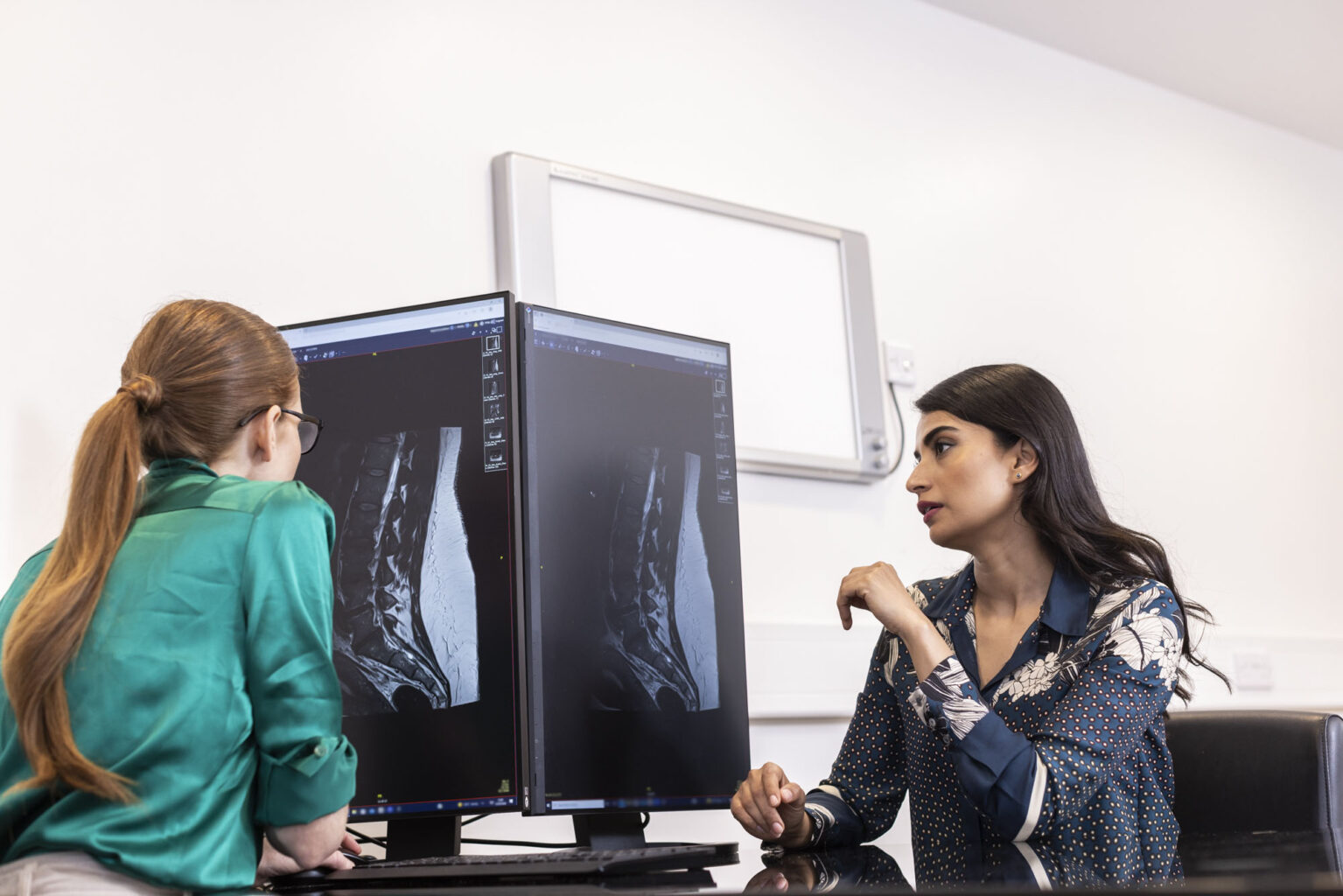Contact number: 020 7806 4060
What Are Spinal Injections?
Spinal injections deliver anti-inflammatory medication, pain relief, or both directly into the affected area of the spine. These injections can treat conditions such as:
- Sciatica: Pain radiating down the leg due to nerve compression.
- Spinal Stenosis: Narrowing of the spinal canal causing pain and weakness.
- Herniated Discs: Pain from bulging or ruptured discs pressing on nerves.
- Arthritis: Inflammation in the facet joints causing stiffness and discomfort.
Spinal injections may be used for diagnosis, pain management, or as part of a broader treatment plan that includes physiotherapy or surgery.
Spinal Injections at St John & St Elizabeth Hospital
At St John & St Elizabeth Hospital, we offer spinal injections as part of our advanced pain management services. Our caring and experienced consultants work with you to create a personalised treatment plan, providing effective relief and improved quality of life.
Why choose us for spinal injections?
- Specialist Pain Management Team: Our experts have extensive experience in performing spinal injections to treat a variety of conditions.
- Personalised Care: We tailor treatment to your specific symptoms and recovery goals.
- Modern Facilities: Our hospital features advanced imaging technology for precise injection placement and effective results.
- Accessible Location: Conveniently based in NW8, we serve patients from Hampstead (NW3), Kilburn (NW6), and the wider London area.
We are dedicated to helping you manage pain and restore mobility through expert, patient-focused care.
How to pay for your treatment
If you’re… paying for yourself
Did you know you don’t need private medical insurance to come to St John & St Elizabeth Hospital? As a self-pay patient, you can access safe, outstanding quality health care at times to suit you.
For scans and tests, as well as to see most consultants, you’ll still need to be referred by a medical professional like your GP, but as a self-pay patient, the process is more straightforward. You won’t need authorisation from an insurance provider, and you’ll have greater choice of consultant and appointment times.
If you’re… insured
St John & St Elizabeth Hospital is approved by all major medical insurance companies. If you have a personal private health insurance policy, or your company provide it for you, you can use it to pay for your care from your initial consultation through to treatment, surgery and aftercare such as physiotherapy. Not all private health insurance plans cover the same things. It’s very important to check exactly what you are covered for with your insurance provider.
Frequently Asked Questions About Spinal Injections
St John & St Elizabeth Hospital is located in St John’s Wood (NW8), a well-connected area of North West London. We are conveniently accessible for patients from Hampstead (NW3), Kilburn (NW6), and beyond.
By Tube:
- St John’s Wood station (Jubilee Line) is just a 5-minute walk from the hospital.
- Finchley Road (NW3) and Kilburn stations (NW6) on the Jubilee Line provide excellent connections.
By Bus:
- Wellington Road: Routes 13, 46, 82, and 113 stop near St John’s Wood Underground Station, just a short walk from the hospital.
- Circus Road: Routes 46 and 187 stop close to the hospital’s Circus Road entrance.
- Abbey Road: Routes 139 and 189 stop near the junction where Grove End Road becomes Abbey Road, providing easy access.
Major Roads:
If you’re travelling from NW3 or NW6, major routes such as Finchley Road or Kilburn High Road offer a direct approach to the hospital.
- Epidural steroid injections. These help relieve pain in the back and in the areas near the spinal nerve roots. Sometimes, they can also be used to reduce arm or leg pain. They are often used to help manage pain caused by a herniated disc, spinal stenosis, or radiculopathy.
- Facet joint injections. The facet joints connect the bones of the spine. Nerve roots pass near these joints and connect the spinal cord to peripheral nerves. This injection works by injecting a mixture of local anaesthetic and steroid (an anti-inflammatory) into the facet joints in your spinal canal. It may be recommended if you suffer from arthritis or other conditions of the facet joints.
- Medial branch nerve blocks: This is a test to see if your neck and back pain is caused by your facet joints. In a medial branch block, your doctor will inject local anaesthetic over the nerves in your facet joint. If this relieves your pain, it will confirm the facet joints are the source of your pain.
- Radiofrequency ablation (aka radiofrequency denervation): This procedure involves putting a needle into the nerves by the facet joints in your back. Radiofrequency waves are then used to damage the nerves to reduce your pain.
- Sacroiliac joint injections: The sacrum is the large bony part at the base of the spine. This injection can be used to diagnose and treat certain types of lower back pain. A mixture of local anaesthetic and steroid is used, which will help reduce pain in the joint as well as tackle surrounding inflammation.
Before your spinal injection, you will have a consultation with one of our specialist consultants who will review your medical history, symptoms, and previous treatments. Imaging studies such as X-rays or MRIs may be used to identify the specific area causing the pain. You may be advised to stop taking certain medications, like blood thinners, before the procedure. Detailed pre-procedure instructions, including fasting and any other preparations, will be provided to ensure a safe and effective injection.
Spinal injections are typically recommended for conditions such as herniated discs, spinal stenosis, sciatica, or chronic back pain that hasn’t responded to other treatments like physical therapy or oral medication. The injections can provide pain relief, reduce inflammation, and promote healing in the affected area.
Spinal injections typically take 15 to 30 minutes, with additional time for preparation and observation afterward.
Most patients experience minimal discomfort during spinal injections. A local anaesthetic is used to numb the area, and the procedure is performed under imaging guidance for accuracy.
Recovery is usually quick, with many patients returning to normal activities the same or next day. Mild soreness at the injection site is normal but typically resolves within a day or two.
After the procedure, you may experience some soreness or temporary discomfort at the injection site, but this typically resolves within a few hours to a few days. Pain relief from the injection can start within a few days, and for some patients, the effects can last for weeks or even months. It’s important to follow post-procedure instructions, including any restrictions on physical activity, to promote healing and avoid complications. If you experience any severe pain or side effects, it’s important to contact your doctor immediately.
The duration of relief varies depending on the condition being treated and the type of injection. Some patients experience relief for several weeks to months, while others may require repeat injections as part of their treatment plan.
Yes, spinal steroid injections can be highly effective for many patients. They provide targeted relief from pain and inflammation caused by conditions such as sciatica, spinal stenosis, or herniated discs. While not a permanent solution, they can significantly improve mobility and quality of life, particularly when combined with physiotherapy or other treatments.
Yes, most patients can walk immediately after a spinal steroid injection. However, it’s recommended to rest and avoid strenuous activities for the first day to ensure the best results and minimise any potential soreness at the injection site.


